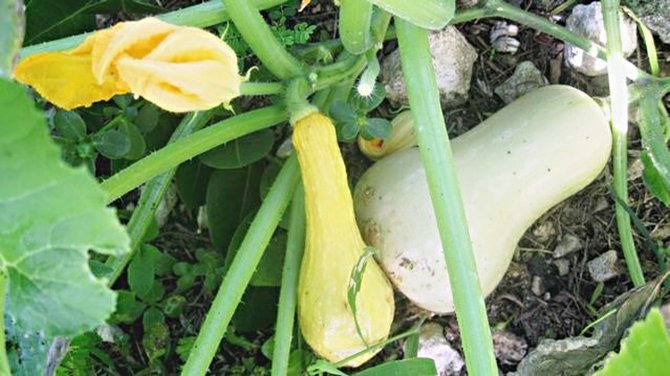Cucurbit is the collective name given to squash, cucumbers, pumpkins, melons and christophenes. The plants are generally vinous and the fruits quick growing.
Most cucurbits are grown in hills, prepared areas that are usually raised a little above the surrounding soil to provide good drainage. The soil in hills is mixed liberally with compost or manure to form a well-conditioned base for fast vine growth and fruit production. Four to six seeds are sown in a hill of 18-inch diameter and the weakest young plants later removed to leave three for production purposes. Add fertilizer to these hills as compost is more of a conditioner than a source of nutrients.
The most common cucumber grown in The Bahamas is the American Ridge, a robust plant that produces cucumbers 6 – 11 inches long with small spines along the surface. When the spines can be easily rubbed off the cucumber is ripe to eat.
The English cucumber should be grown on trellises so it hangs and produces straight fruits. The English cucumber is milder than Ridge and takes longer to develop. Armenian cucumber is not a cucumber at all but a type of squash.
Summer squash comes in several shapes. The most common summer squash look like small bowling pins but there are also patty-shaped and globular summer squash. Zucchini is a summer squash and the fruits are usually green or yellow or a dramatic mixture of the two. Summer squash are usually not vinous and can be grown in small individual hills.
Winter squash is so called because the outer skin of the fruits is hard and allows for longer storage. They also take longer to produce fruits. Acorn, Spaghetti, and Butternut are the most popular varieties of winter squash. Once harvested winter squash can be kept in a cool location for several months.
Virtually the only pumpkin used for savoury purposes in the Bahamas is the Cuban or calabaza pumpkin. The outside is mottled green and tan and the shape varies from roughly round to somewhat necked.
Calabaza vines should be grown using substantial hills but thereafter they often put down roots along their length and ‘walk’. I have heard about a vine that left one yard and established itself in another.
You will not find calabaza pumpkins in the seed racks at your local nursery. Seeds are best obtained by buying a wedge of large calabaza from a street vendor.
If you are fortunate enough to have some rich soil near a chain-link fence you should try to grow christophenes, pear-shaped squash that grow from rampant vines. There are several problems with growing christophenes. The whole fruit must be planted and the fruits you buy in the food store are young and well short of maturity. Your best source would be from a gardener who already has christophenes established.
Ensure you grown plenty of your favourite squash because once female flowers appear they need to have male flowers available. If you grow only a few plants you may miss out on germination. With calabaza pumpkin you may have to become the agent for pollination, even if you have both male and female flowers. Male flowers are stripped of their petals and introduced into the female receptacle. The female petals are then tied around the mass using love vine as string. Pollen can also be transferred by using a cotton swab or artist’s paint brush.
Young cucurbit leaves look wondrously healthy but in time are attacked by fungus spores, mildew, and other airborne diseases. A fungal spray will help but may only delay the demise of the plant. Concentrate on the fruits. If they are growing well, do not worry too much about the ragged and ugly vine.
• j.hardy@coralwave.com





Comments
Use the comment form below to begin a discussion about this content.
Sign in to comment
Or login with:
OpenID